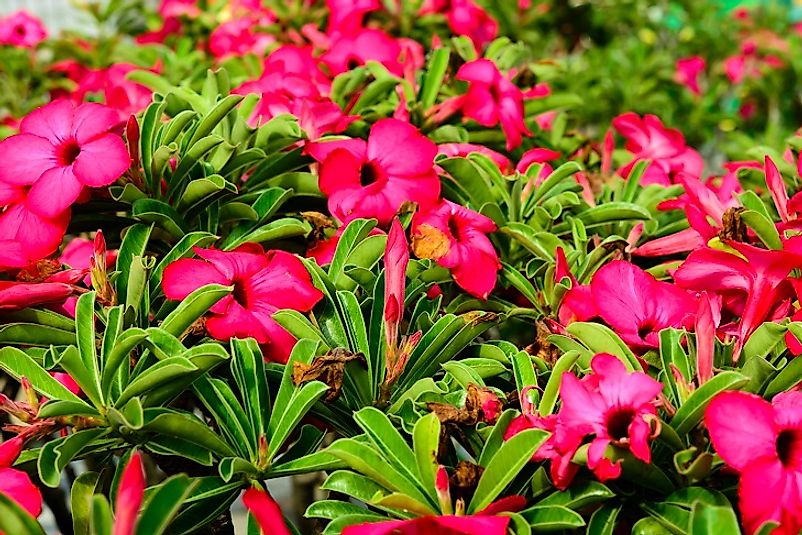Native Plants Of Saudi Arabia

Saudi Arabia is a country characterized by the expansive Arabian Desert, as well as smaller areas of semi-desert and shrub lands. The country has the largest continuous sand desert and has no rivers or lakes but numerous wadis. Saudi Arabia has a desert climate with high temperatures during the day and low annual rainfall. The flora of Saudi Arabia consists of 2285 species distributed across the country. Most of the species grow on mountains, wadis, and meadows. Only 2.5% of the plant species are endemic to the country despite the size of Saudi Arabia. Some of these native plants are discussed below.
Desert Rose
The Desert Rose, scientifically named Adenium obesum, is a flowering plant species in the dogbane family. It is native to the tropical and subtropical regions of Saudi Arabia. It is an evergreen succulent shrub which can grow to 1 to 3 meters in height. It has a pachycaul stems and a basal caudex with spirally arranged leaves which are clustered towards the tip of the shoot. The red and pink flowers are tubular around 3 to 5 centimeters long with five petals. The flowers have a blush outwards on the throat. The roots and stem of a desert rose contain a cardiac glycoside used as arrow poison and fish toxin. The photo of Desert Rose has been used on postage stamps issued by some countries. The major threats to this plant species include pest and diseases.
Red Acacia
The Red Acacia, Vachellia seyal, is a medium-sized thorny tree which can grow to 6 to 17 meters tall and 60 centimeters in diameter. It has a pale greenish or reddish bark with feathery leaves and straight light grey thorns which occur near the tip of the branches. Its crown is umbrella shaped. Red Acacia is native to Saudi Arabia and part of North and East Africa. The plant has several uses including a source of wood for making coffins, a source of gum Arabic, fumigant, and as tanning. The bark can be used as a cattle feed and for the treatment of dysentery. Because of the many uses and benefits, the plant is in high demand with logging being its major threat.
Charcoal Tree
The Charcoal Tree, Trema orientalis, is a flowering species in the Family Cannabaceae. It is distributed universally in the tropical and warm temperate parts of the world. It has a high ecological impact with over 15 butterfly species and several birds feeding on its leaves and fruits respectively. It is also home to several insects, pigeons, and doves. Its leaves are also used as fodder for livestock and buffalo. Charcoal Tree has medicinal values in some cultures. The leaves and barks can be used to treat a sore throat and coughs. The wood can be used to produce paper while in Tanzania the wood is used to make charcoal. Logging and clearing of vegetation are major threats to the Charcoal Tree.
Arabian Bonatea
The Arabian Bonatea , Bonatea steudneri, is a perennial herb which can grow to 25 to 125 centimeters in height. It has a green to yellowish green spreading flowers with a strong fragrant. It has a leafy stem with seven ovate and clasping leaves which bloom in the fall. Arabian Bonatea is native to Saudi Arabia, Yemen, and the East and North Africa within an altitude range of 1,650 to 1,800 meters above sea level. The species has a significant horticultural value in Saudi Arabia.
Native Plants Of Saudi Arabia
| Native Plants of Saudi Arabia | Scientific Name |
|---|---|
| Desert Rose | Adenium obesum |
| Red Acacia | Vachellia seyal |
| Arabian Bonatea | Bonatea steudneri |
| Charcoal Tree | Trema orientalis |
| Egyptian Meadow Saffron | Colchicum ritchii |
| Blood Lily | Scadoxus multiflorus |
| White Saxaul | Haloxylon persicum |
| African Juniper | Juniperus procera |
| Cemetery Iris | Iris albicans |
| Royal Jasmine | Jasminum grandiflorum |







